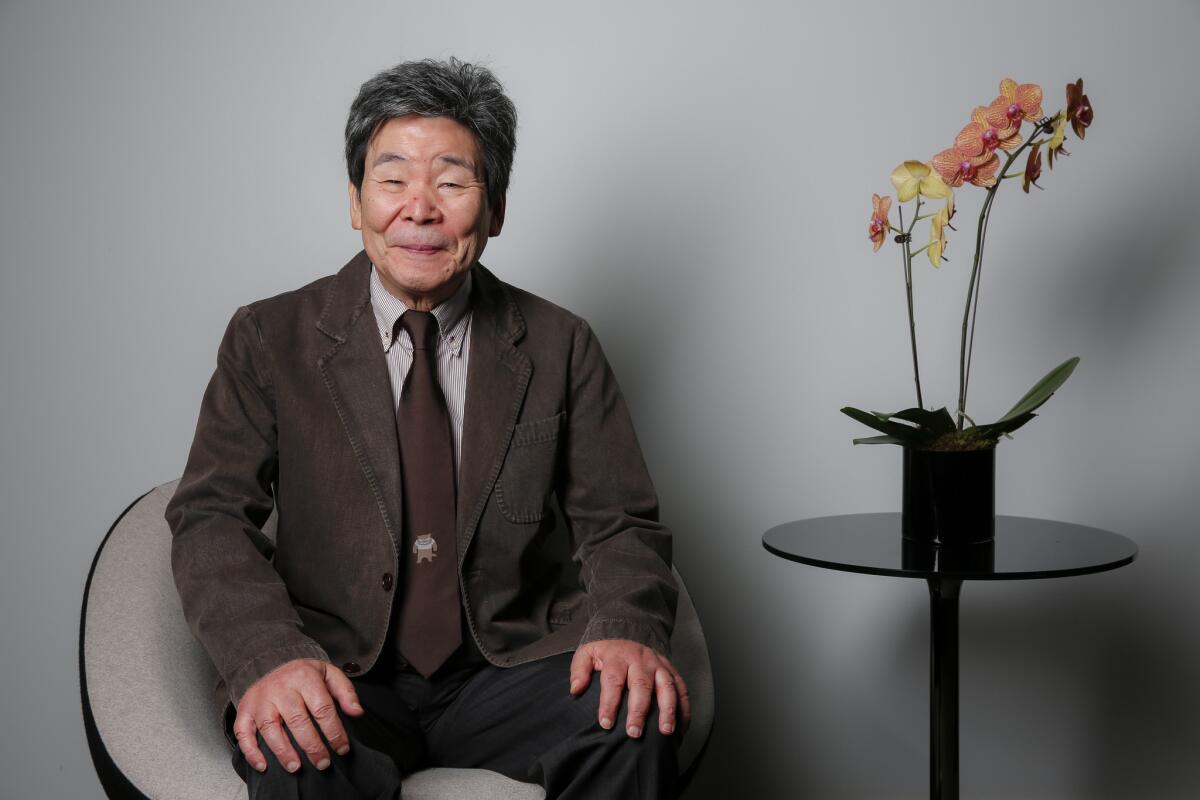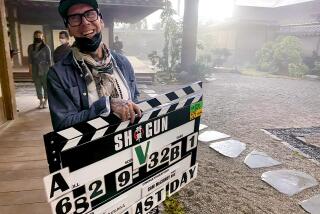Isao Takahata of Studio Ghibli surfaces with ‘Princess Kaguya’

- Share via
For many fans of Japanese animation, the name Studio Ghibli has become synonymous with the fantastic worlds and deeply felt emotions of director Hayao Miyazaki. This is, in part, because Miyazaki’s founding partner in the studio, Isao Takahata, went 14 years without making a feature film.
With “The Tale of the Princess Kaguya,” playing now in Los Angeles, Takahata, who turns 79 on Oct. 29, has returned with a film both light and heavy, with its delicate, painterly look supporting an emotional intensity.
------------
For the Record
Oct. 21, 11:08 a.m.: An earlier version of this article gave the title of Isao Takahata’s new film as “The Tale of Princess Kaguya.” The correct title is “The Tale of the Princess Kaguya.”
------------
In the time since his previous film, Takahata has not simply sat still. Among other projects, he has published numerous books, including a survey of historical animation and one on fine art.
“I’m quite a dilettante,” he during a recent phone call from Tokyo. “I like all kinds of things.”
Takahata first had the idea for the film decades ago, and that exacting, unhurried sense of curiosity and exploration comes through in the film. The project took eight years of recent work from start to finish with its hand-drawn images by the Studio Ghibli team and assistance from computers for backgrounds and animation.
“In order to really understand where Studio Ghibli is coming from, I think you really have to be familiar with Takahata’s films as well as Miyazaki’s,” said Dave Jesteadt, director of distribution at GKIDS, which is releasing “Princess Kaguya.” The company has put out numerous Studio Ghibli titles and will also be releasing “The Kingdom of Dreams and Madness,” a documentary on the making of Miyazaki’s recent “The Wind Rises,” by the end of the year.
“If Studio Ghibli is your favorite band, then Takahata has the deep cuts from the back catalog,” Jesteadt said. “And it presents a really interesting contrast to some of the films people are familiar with when they think of Ghibli.”
“The Tale of the Princess Kaguya” is drawn from a 10th century Japanese folk tale known as “The Tale of the Bamboo Cutter.” In the film, a poor rural man who makes his living cutting bamboo discovers a small baby girl growing inside a stalk. Though the girl is said to be from the Kingdom of the Moon, the man and his wife raise her as their child. As she grows, she rebuffs many wealthy suitors, holding out hope to be with a local boy she knows from her youth, until she is eventually torn away from her Earth-bound life and family and forced to return to her otherworldly home.
The film opened in Japan at the end of last year and went on to the Cannes Film Festival before playing at the Toronto International Film Festival, and has been met internationally by near-universal critical acclaim. The Times’ Kenneth Turan hailed it as “a parable about what matters in life and what does not.” While calling the film “a staggering masterpiece,” critic Glenn Kenny, writing at RogerEbert.com, called the film “both very simple and head-spinningly confounding, a thing of endless visual beauty… a true work of art.”
The look of the film has generated just as much talk as the storytelling, with an organic flowing quality that is for many reminiscent of the soft colors and fluid, impressionistic images of watercolor painting.
“I wanted to give life to the line,” Takahata said regarding the film’s distinctively ephemeral look, an extension of techniques he first explored with his previous feature, 1999’s “My Neighbors the Yamadas.”
“Well, certainly I have no word to describe the style that I use. I don’t have a name for it,” he added. “Even with watercolors, there are many styles, so I wouldn’t want to label it as watercolor.
“Of course it helps to have very well-drawn features, but what I like to have come from the film is the feeling of the moment, the feeling of the characters. So in this film of ours, we used lines and forms that are not maybe completely finished, but my whole intent was to really convey the feeling of that moment, of that story.”
Though it may seem unusual that Takahata is dismissive of his own abilities to draw, he is quick to note that Walt Disney did not draw on his most famous films. “If you want to make an animated film from your own drawings, I think you would become very narrow and limited by your own style and abilities. The role of the director is to gather very talented people, and to direct his vision.”
In a documentary made for Japanese television on the making of “Princess Kaguya,” Takahata is captured barely pausing from his own work to watch a broadcast of the news conference at which Miyazaki, an Oscar winner for “Spirited Away,” announced his retirement. Miyazaki may be better known — he is receiving an honorary Oscar at this year’s Governors Awards — but it is the push-and-pull of the long relationship between him and Takahata that has allowed them both to achieve greatness.
“I have said that Hayao Miyazaki’s retirement announcement shouldn’t be a surprise,” Takahata said. “I still have hopes for him, that he can perhaps make another film. I really want him to.”
Though Miyazaki, 73, declared “The Wind Rises” his last film, the older Takahata feels no such compulsion. Their differing approaches to the twilight of their careers underscore how, even though the pair may be great friends and colleagues — they have known each other more than 50 years — they are very different as filmmakers. Takahata’s work is marked by a moodiness that is in contrast to Miyazaki’s sense of wonder. There is also perhaps some sense of competition fueling their work.
“I don’t want to say that I want to retire or that I have retired,” Takahata said. “I still have films that I might want to make, but there’s a reality of whether I can make them or not at my age. I’m very fortunate to work with very talented people, and I certainly don’t plan on retiring and don’t want to say that I am retired.”
The fervent fandom around Studio Ghibli could be seen last summer when comments from a news conference in Japan by producer Toshio Suzuki were misunderstood in translation to mean that Studio Ghibli was closing. (It’s not.) Yet the outpouring of concern and emotion over the possibility created an uproar.
Now, they have much to cheer with at least this one more film from the quiet master of Takahata. With rave reviews, the film looks to be competitive in the race for the animated feature Oscar.
“If this happens to be his last film,” said Jesteadt, “I think everyone involved just feels like this is a wonderful, amazing masterpiece of a film, one of the best films we’ve been fortunate enough to release. To be involved in any way is incredibly special.”
Follow me on Twitter: @IndieFocus
More to Read
Only good movies
Get the Indie Focus newsletter, Mark Olsen's weekly guide to the world of cinema.
You may occasionally receive promotional content from the Los Angeles Times.











